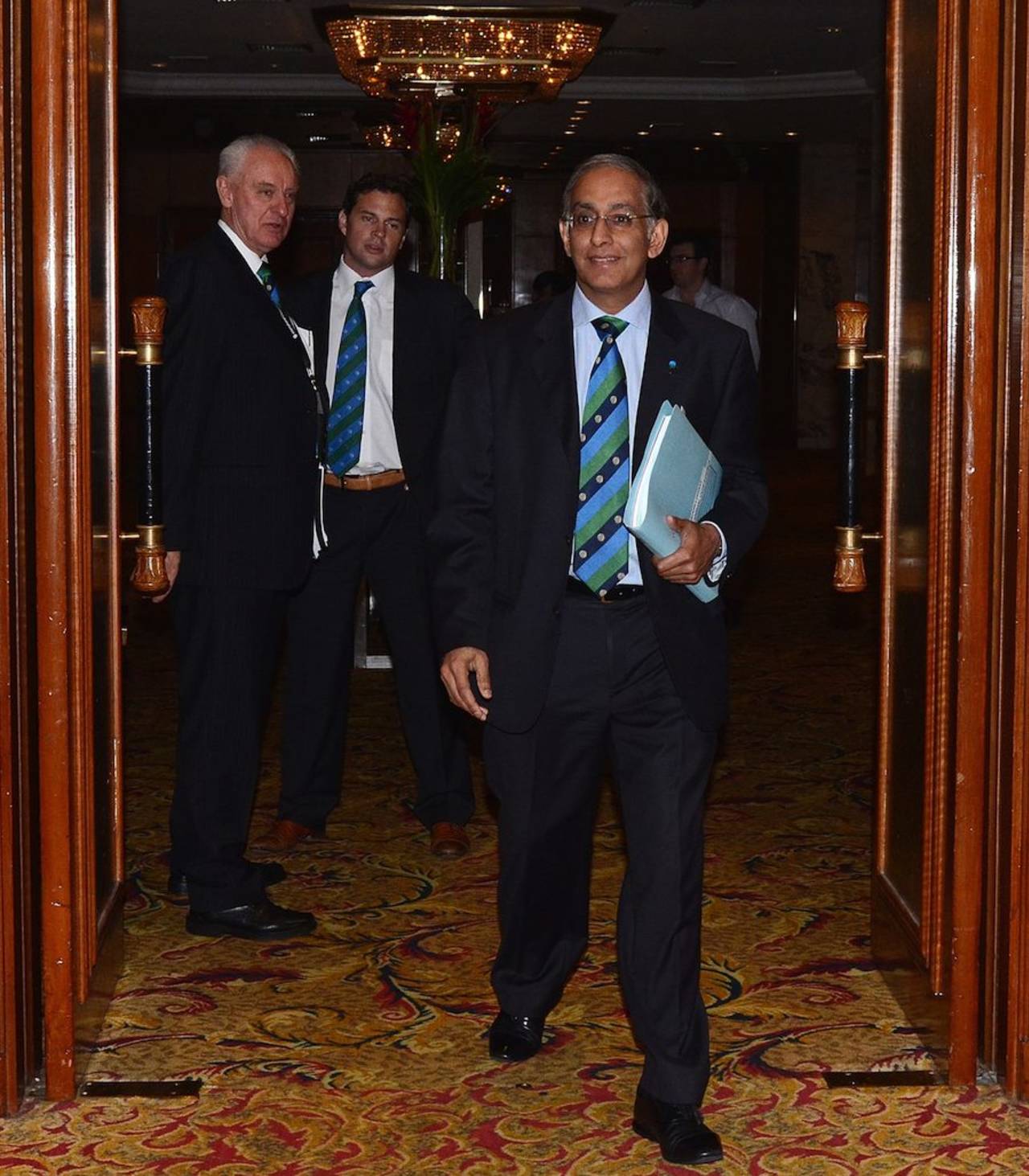Big three eye bigger slice of ICC revenue pie
A new ICC proposal has recommended the introduction of a new revenue stream for Full Members to be earned from ICC's gross revenues and distributed to members through a graded percentage share
Sharda Ugra and Abhishek Purohit
18-Jan-2014

The Full Member board left out of the Test Cricket Fund is Cricket South Africa • Getty Images
The proposal by a "working group" of the ICC's Finance & Commercial Affairs (F&CA) to revamp ICC administration and distribution of its earnings, has recommended the introduction of a revenue stream for Full Members called, under various heads, "Distribution Costs/Contribution Costs/Participation Fee" to be earned from ICC's gross revenues and distributed to members through a graded percentage share, worked out by a "marked scoreboard method."
According to current practice, the ICC gave 75% share of its 'surplus' (revenues minus costs) from events to ten Full Member nations and distributed the remaining 25% to Associates and Affiliates. Distributing the gross revenues on a graded percentage to ten member boards - with three, the BCCI,ECB and CA, earning more than the rest - means reducing the percentage of surplus from ICC events. This will affect the 25% share to be distributed among Associates and Affiliates (A&A), of which, the proposal recommends giving the top six half the share of the 25%.
The "position paper" drafted by the F&CA committee's "working group" effectively cedes most executive decision-making in the ICC and control of its finances to the BCCI, Cricket Australia and the ECB. A draft proposal on these lines will be presented to the ICC Executive Board during its quarterly meeting in Dubai on January 28 and 29.
The "marked scoreboard method" cited as a benchmark for the percentage distribution of gross revenues will be based on four parameters: revenue contributed to the ICC, historical ICC membership, on-field performance over past 20 years in men's and women's competitions and domestic development performance.
The draft document states that during the last ICC media rights and sponsorship process, the "value contribution" of India was over 80% while the contribution of other Full Members ranged from 0.1% to 5%. There is no supporting evidence of this estimate available in the document, but the working paper states that "calculations have been worked on and negotiated by BCCI, CA and ECB. Agreed principles are sound and breakup between categories appropriate."
Given that revenue contributed to the ICC is a major parameter for the contribution/ distribution cost, the BCCI could earn $63 million and the BCB nothing as "Contribution" fees from the current revenue levels of $1.5 billion. Should the revenue increase, the BCCI, the ECB and the CA stand to gain a much larger share (If revenue levels rise to $3.5 billion, the BCCI could earn $766 million).
These earnings will be over and above the share of the surplus: each Full Member board would earn $52 million at current revenue levels, but an estimated $85 million if revenue increases to $3.5 billion.
The "distribution model" forms the bulk of the position paper and recommends setting up a Test Cricket Fund for six of the remaining seven members outside the BCCI-CA-ECB triumvirate. The Full Member board left out of the Fund is Cricket South Africa but the draft available does not specifically mention the omission nor its reason or purpose. The fund is set up in order to ensure that "uneconomical tours" (which do not find their way into newly recommended FTP agreements) do not lead to "no Test cricket being played - or inappropriately too little Test cricket - being played by Full Members." The fund is to be distributed among BCB, ZC, NZC, SLC, PCB and WICB, who will have to report utilisation annually to F&CA. As it is proposed, the sum will begin at a total of $30 million for a revenue level of $2.25 billion and be $90 million at a revenue level of $3.5 billion.
The development expenditure on Associates and Affiliates (A&A), according to the position paper, derives insufficient returns. It recommends the scaling down of financial authority of the Development Committee, who must now report and seek fund sources from the F&CA (which is the central recommendation committee on all financial and commercial matters, personnel, event management). Of the A&A's 25% share of the surplus, it is recommended that half should be given to the top six Associates.
The proposal also states that ICC costs can be reduced, at a conservative level, "by 15-20%" and calls for a revisiting of the vastly different operational costs for events between 2000-07 ($220 million), and 2007-15 ($317 million). The BCCI-CA-ECB have also recommended the formation of a "standing team" of representatives from each of the Boards who have a mandate to look at "every element of each ICC event and event costs" and will regularly report to the F&CA committee.
The "position paper" describes the ICC as "merely an organisation leveraging the rights for and on behalf of members by conducting events." It is observed that "members are providing their players and playing windows for ICC events," which restricts, "some members' ability to play their own events." At the moment, the ICC events requiring the players from Full Member nations and therefore affecting their player windows, are the men's and women's World Cups, the U-19 World Cup and the World T20. The Champions Trophy, begun in 1998 to initially generate ICC funding and restricted to the top eight member nations, has been called to a halt, but the proposal does refer to its reinstatement over the World Test Championship in 2017 and 2021.
Sharda Ugra is senior editor at ESPNcricinfo; Abhishek Purohit is a sub-editor at ESPNcricinfo